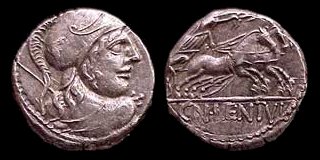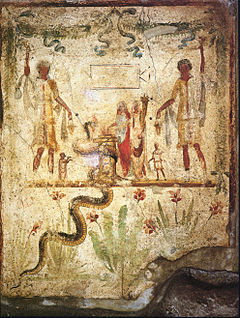
The Ides of March is the 74th day in the Roman calendar, corresponding to 15 March. It was marked by several religious observances and was a deadline for settling debts in Rome. In 44 BC, it became notorious as the date of the assassination of Julius Caesar, which made the Ides of March a turning point in Roman history.

Vesta is the virgin goddess of the hearth, home, and family in Roman religion. She was rarely depicted in human form, and was more often represented by the fire of her temple in the Forum Romanum. Entry to her temple was permitted only to her priestesses, the Vestal Virgins, who guarded particular sacred objects within, prepared flour and sacred salt for official sacrifices, and tended Vesta's sacred fire at the temple hearth. Their virginity was thought essential to Rome's survival; if found guilty of inchastity, they were buried or entombed alive. As Vesta was considered a guardian of the Roman people, her festival, the Vestalia, was regarded as one of the most important Roman holidays. During the Vestalia privileged matrons walked barefoot through the city to the temple, where they presented food-offerings. Such was Vesta's importance to Roman religion that following the rise of Christianity, hers was one of the last non-Christian cults still active, until it was forcibly disbanded by the Christian emperor Theodosius I in AD 391.

The lemures were shades or spirits of the restless or malignant dead in Roman religion, and are probably cognate with an extended sense of larvae as disturbing or frightening. Lemures is the more common literary term but even this is rare: it is used by the Augustan poets Horace and Ovid, the latter in his Fasti, the six-book calendar poem on Roman holidays and religious customs.

A religious festival is a time of special importance marked by adherents to that religion. Religious festivals are commonly celebrated on recurring cycles in a calendar year or lunar calendar. The science of religious rites and festivals is known as heortology.
Cardea or Carda was the ancient Roman goddess of the hinge, Roman doors being hung on pivot hinges. The Augustan poet Ovid conflates her with another archaic goddess named Carna, whose festival was celebrated on the Kalends of June and for whom he gives the alternative name Cranê or Cranea, a nymph. Ovid's conflation of the goddesses is likely to have been his poetic invention, but it has also been conjectured that Carna was a contracted form of Cardina, and at minimum Ovid was observing that their traditions were congruent.

Religion in ancient Rome consisted of varying imperial and provincial religious practices, which were followed both by the people of Rome as well as those who were brought under its rule.

Festivals in ancient Rome were a very important part in Roman religious life during both the Republican and Imperial eras, and one of the primary features of the Roman calendar. Feriae were either public (publicae) or private (privatae). State holidays were celebrated by the Roman people and received public funding. Games (ludi), such as the Ludi Apollinares, were not technically feriae, but the days on which they were celebrated were dies festi, holidays in the modern sense of days off work. Although feriae were paid for by the state, ludi were often funded by wealthy individuals. Feriae privatae were holidays celebrated in honor of private individuals or by families. This article deals only with public holidays, including rites celebrated by the state priests of Rome at temples, as well as celebrations by neighborhoods, families, and friends held simultaneously throughout Rome.
The Lemuralia or Lemuria was an annual event in the religion of ancient Rome, during which the Romans performed rites to exorcise any malevolent and fearful ghosts of the restless dead from their homes. These unwholesome spectres, the lemures or larvae were propitiated with chants and offerings of black beans.
The Robigalia was a festival in ancient Roman religion held April 25, named for the god Robigus. Its main ritual was a dog sacrifice to protect grain fields from disease. Games (ludi) in the form of "major and minor" races were held. The Robigalia was one of several agricultural festivals in April to celebrate and vitalize the growing season, but the darker sacrificial elements of these occasions are also fraught with anxiety about crop failure and the dependence on divine favor to avert it.

Christmastide is a season of the liturgical year in most Christian churches. In some, Christmastide is identical to Twelvetide.
In ancient Rome, the Parentalia or dies parentales was a nine-day festival held in honor of family ancestors, beginning on 13 February.
Ferālia was an ancient Roman public festival celebrating the Manes which fell on 21 February as recorded by Ovid in Book II of his Fasti. This day marked the end of Parentalia, a nine-day festival honoring the dead ancestors.

The Equirria were two ancient Roman festivals of chariot racing, or perhaps horseback racing, held in honor of the god Mars, one 27 February and the other 14 March.
An Agonalia or Agonia was an obscure archaic religious observance celebrated in ancient Rome several times a year, in honor of various divinities. Its institution, like that of other religious rites and ceremonies, was attributed to Numa Pompilius, the semi-legendary second king of Rome. Ancient calendars indicate that it was celebrated regularly on January 9, May 21, and December 11.

The Fasti, sometimes translated as The Book of Days or On the Roman Calendar, is a six-book Latin poem written by the Roman poet Ovid and published in AD 8. Ovid is believed to have left the Fasti incomplete when he was exiled to Tomis by the emperor Augustus in 8 AD. Written in elegiac couplets and drawing on conventions of Greek and Latin didactic poetry, the Fasti is structured as a series of eye-witness reports and interviews by the first-person vates with Roman deities, who explain the origins of Roman holidays and associated customs—often with multiple aetiologies. The poem is a significant, and in some cases unique, source of fact in studies of religion in ancient Rome; and the influential anthropologist and ritualist J.G. Frazer translated and annotated the work for the Loeb Classical Library series. Each book covers one month, January through June, of the Roman calendar, and was written several years after Julius Caesar replaced the old system of Roman time-keeping with what would come to be known as the Julian calendar.
In ancient Roman religion, the Fordicidia was a festival of fertility, held on the Ides of April, that pertained to farming and animal husbandry. It involved the sacrifice of a pregnant cow to Tellus, the ancient Roman goddess of the Earth, in proximity to the festival of Ceres (Cerealia) on April 19.
Polemius Silvius was the author of an annotated Julian calendar that attempted to integrate the traditional Roman festival cycle with the new Christian holy days. His calendar, also referred to as a laterculus or fasti, dates to around 448–449. He was active in southeastern Gaul.

Aprilis or mensis Aprilis (April) was the second month of the ancient Roman calendar, following Martius (March) and preceding Maius (May). On the oldest Roman calendar that had begun with March, Aprilis was the second of ten months in the year. April had 29 days on calendars of the Roman Republic, with a day added to the month during the reform in the mid-40s BC that produced the Julian calendar.

In the Roman Empire, Rosalia or Rosaria was a festival of roses celebrated on various dates, primarily in May, but scattered through mid-July. The observance is sometimes called a rosatio ("rose-adornment") or the dies rosationis, "day of rose-adornment," and could be celebrated also with violets (violatio, an adorning with violets, also dies violae or dies violationis, "day of the violet[-adornment]"). As a commemoration of the dead, the rosatio developed from the custom of placing flowers at burial sites. It was among the extensive private religious practices by means of which the Romans cared for their dead, reflecting the value placed on tradition (mos maiorum, "the way of the ancestors"), family lineage, and memorials ranging from simple inscriptions to grand public works. Several dates on the Roman calendar were set aside as public holidays or memorial days devoted to the dead.

The Tiberinalia is a Roman festival of late antiquity, recorded in the Calendar of Filocalus, on August 17 (XVI Kal. Sept.), the same day as the archaic Portunalia. As a festival honoring Father Tiber, it may reflect renewed Imperial patronage of traditional Roman deities, in particular the dedication made to Tiberinus by the emperors Diocletian and Maximianus.










